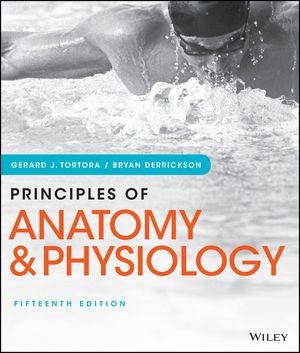
Principles of Anatomy and Physiology, 15th Edition
By Gerard J. Tortora, Bryan Derrickson
Designed for the two-semester Anatomy and Physiology course, this program combines exceptional content and visuals for a rich and comprehensive classroom experience. Enhanced for a digital delivery, this new version gives students the ability to learn and explore Anatomy and Physiology both inside and outside of the classroom.
WileyPLUS Next Gen for Principles of Anatomy and Physiology gives you the freedom and flexibility to tailor Anatomy and Physiology content and easily manage your course in order to keep students engaged and on track.
Schedule a Demo Sign Up for a Test Drive Adopt WileyPLUSWant to learn more about WileyPLUS? Click Here

True-to-life anatomical structures software provides extra practice.
Real Anatomy 2.0 is a 3-D imaging software that allows students to dissect through over 40 layers of a real human body to study the anatomical structures of all body systems. Using Real Anatomy, students can interact and practice with a real cadaver as much as they need from the comfort of their own computer.
3-D Animations bring physiology to life.
3-D Physiology is an animation series that breaks down the most difficult physiological concepts for you to teach and your students to learn.
Concept Lectures give students more opportunities to learn.
Created by author Mark Nielsen, Concept Lectures provide a great resource for professors who want to incorporate more of a flipped classroom into their teaching. These video lectures are a dynamic way to help students focus on key concepts and patterns in anatomy.
- Principles of Anatomy & Physiology Enhancements: These include expanded and updated physiology coverage throughout the course, new scanning electron microscope (SEM) images, and significant updates to the art in the Cardiovascular System in Sections 20 and 21.
- Adaptive Practice: Every student has a different starting point, and adaptive practice provides endless opportunities for practice to effectively prepare for class or quizzes and exams. Active retrieval of information with practice questions is proven to improve retention of information better than re-reading or reviewing the material, and students who use adaptive practice to prepare for exams do significantly better than those who do not. Students begin with a quick, section-level diagnostic to determine their initial level of understanding, and they can use the dashboard and quick reports to see what topics they know and don’t know.
- Interactive eTextbook: Students can easily search content, highlight and take notes, access instructor’s notes and highlights, and read offline.
What’s New:

GERARD J. TORTORA is a professor of biology and former biology coordinator at Bergen Community College in Paramus, New Jersey, where he teaches human anatomy and physiology as well as microbiology. He received his bachelor’s degree in biology from Fairleigh Dickinson University and his master’s degree in science education from Montclair State College. He is a member of many professional organizations including the Human Anatomy and Physiology Society (HAPS), the American Society of Microbiology (ASM), the American Association for the Advancement of Science (AAAS), the National Education Association (NEA), and the Metropolitan Association of College and University Biologists (MACUB).
Above all, Tortora is devoted to his students and their aspirations. In recognition of this commitment, he was the recipient of MACUB’s 1992 President’s Memorial Award. In 1996, he received a National Institute for Staff and Organizational Development (NISOD) excellence award from the University of Texas and was selected to represent Bergen Community College in a campaign to increase awareness of the contributions of community colleges to higher education.

Bryan Derrickson is Professor of Biology at Valencia College in Orlando, Florida, where he teaches human anatomy and physiology as well as general biology and human sexuality. He received his bachelor’s degree in biology from Morehouse College and his Ph.D. in cell biology from Duke University. Bryan’s study at Duke was in the Physiology Division within the Department of Cell Biology, so while his degree is in cell biology, his training focused on physiology. At Valencia, he has served as a member of the Faculty Senate, which is the governing body of the college, and as a member of the Faculty Academy Committee (now called the Teaching and Learning Academy), which sets the standards for the acquisition of tenure by faculty members. Nationally, he is a member of the Human Anatomy and Physiology Society (HAPS) and the National Association of Biology Teachers (NABT). Bryan has always wanted to teach. Inspired by several biology professors while in college, he decided to pursue physiology with an intent to teach at the college level. He is completely dedicated to the success of his students. He particularly enjoys the challenges of his diverse student population, in terms of their age, ethnicity, and academic ability, and finds being able to reach all of them a rewarding experience. His students continually recognize Bryan’s efforts and care by nominating him for a campus award known as the “Valencia Professor Who Makes Valencia a Better Place to Start.” Bryan has received this award three times.
- An Introduction to the Human Body
- The Chemical Level of Organization
- The Cellular Level of Organization
- The Tissue Level of Organization
- The Integumentary System
- The Skeletal System: Bone Tissue
- The Skeletal System: The Axial Skeleton
- The Skeletal System: The Appendicular Skeleton
- Joints
- Muscular Tissue
- The Muscular System
- Nervous Tissue
- The Spinal Cord and Spinal Nerves
- The Brain and Cranial Nerves
- The Autonomic Nervous System
- Sensory, Motor and Integrative Systems
- The Special Senses
- The Endocrine System
- The Cardiovascular System: The Blood
- he Cardiovascular System: The Heart
- The Cardiovascular System: Blood Vessels and Hemodynamics
- The Lymphatic System, Nonspecific Resistance to Disease, and Immunity
- The Respiratory System
- The Digestive System
- Metabolism
- The Urinary System
- Fluid, Electrolyte, and Acid-Base Homeostasis
- The Reproductive Systems
- Development and Inheritance

